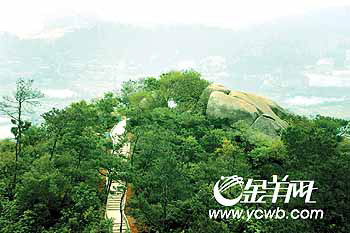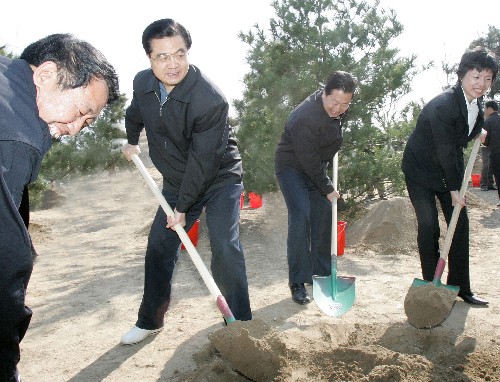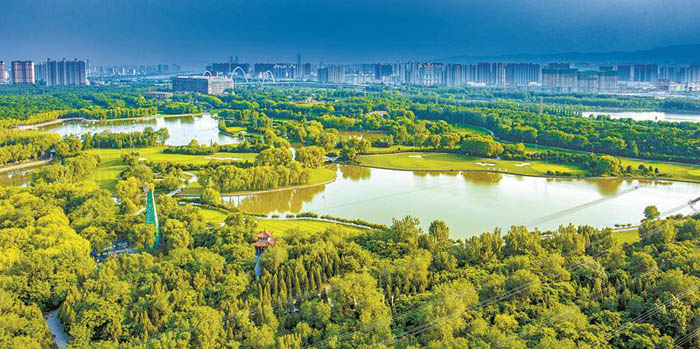
不同城市热岛梯度下公园冷岛效应和景观特征的关联机制
编号
lyqk011412


中文标题
不同城市热岛梯度下公园冷岛效应和景观特征的关联机制


作者单位
1. 青岛农业大学园林与林学院 山东青岛 266109;
2. 棕榈建筑规划设计(北京)有限公司 北京 100016;
3. 中国科学院生态环境研究中心城市与区域生态国家重点实验室 北京 100085


期刊名称
中国城市林业


年份
2024


卷号
22


期号
2


栏目名称
专题1:城市绿地热缓解


中文摘要
城市公园形成的冷岛效应已成为缓解城市热环境的重要途径之一。利用Landsat 8 OLI-TIRS、Google Earth遥感数据,通过辐射传导算法反演济南市22个公园的地表温度;采用缓冲区分析、多元统计和相关性分析等方法定量分析公园内部平均温度、公园冷岛效应与公园内部机理以及城市形态两大景观特征之间的关系;利用增长回归树模型初步探究景观特征的贡献能力。结果表明:1)不同城市热岛梯度下公园冷岛效应呈梯度变化,热岛等级高的公园,其冷岛效应更显著; 2)当公园面积达到200 hm2、水体面积达到45 hm2、绿地面积在80~100 hm2时,公园的冷岛效应最佳,水体比绿地的冷却效果更强;3)建筑高度与冷岛效应相关性最显著,当建筑高度在35~63 m时,最大冷却距离随高度的增大而增加,过高过密且杂乱无序的建筑环境阻碍公园冷岛效应;4)内在机理对公园地表温度、最大冷却距离、冷却强度的贡献能力强于外部城市形态指标,外部城市形态对冷却梯度的贡献能力更强。因此,在不同城市热岛梯度下,将公园绿地、水体面积控制在阈值内,适当增加公园轮廓复杂度和不透水面积,并利用城市风廊增加公园冷空气溢出途径,能够改善公园周围热环境、提高人体舒适度。


基金项目
国家自然基金青年基金(31800448);青岛农业大学高层次人才科研基金(6631118009;6631119001)


英文标题
Correlation Mechanism Between Parks' Cold Island Effect and Landscape Characteristics under Different Urban Heat Island Gradients


作者英文名
Li Chunyu, Zhang Yu, Shi Peng, Chen Sifan, Wang Yuru, Liang Hong, Wang Kai


单位英文名
1. College of Landscape Architecture and Forestry, Qingdao Agricultural University, Qingdao 266109, Shandong, China;
2. Palm Architecture Planning and Design (Beijing) Co., Ltd., Beijing 100016, China;
3. State Key Laboratory of Urban and Regional Ecology, Research Center for Eco-Environmental Sciences, Chinese Academy of Sciences, Beijing 100085, China


英文摘要
The cold island effect created by urban parks has become one of the important ways to alleviate the urban thermal environment. Using Landsat 8 OLI-TIRS and Google Earth remote sensing data, the paper inverted the surface temperature of 22 parks in Jinan City by means of a radiation transmission algorithm. The methods of buffer zone analysis, multiple statistics, and correlation analysis are adopted to quantify and analyze the relationship between the average temperature inside the parks, parks' cold island effect, the internal mechanism of parks, and two landscape features of urban morphology. The contribution of landscape characteristics is initially investigated using the growth regression tree model. The study finds:1) The park cold island effect presents the gradient changes under the different heat island gradients in the city. The park with higher level of heat island effect has the largely significant cold island effect; 2) When park area reaches 200 hm2, water bodies reach the area of 45 hm2, and the green area is between 80 and 100 hm2, the best cool island effect of parks can achieve, while water bodies have better cooling effect than green spaces; 3) The correlation between the building height and the cold island effect is extremely significant. When buildings are 35-63 m high, the maximum cooling distance increases with the building height, and the overcrowded and disorderly buildings will not give play to parks' cold island effect; and 4) The internal mechanisms have greater contributions to park surface temperature, maximum cooling distance and cooling intensity than the external index of urban morphology, but urban morphology has a greater contribution to the cooling gradient. Hence, it is suggested that, under different urban heat island gradients, the thermal environment around parks as well as the human comfort could be improved through controlling the area of green spaces and water bodies in parks within the threshold, appropriately complicating park contours and increasing the impermeable area, and using urban wind corridors to make more cool air overflow.


英文关键词
heat-island effect;city park;cold island effect;surface temperature of park;Jinan City


起始页码
17


截止页码
25


投稿时间
2023/8/4


作者简介
李春雨(1999-),女,硕士,研究方向为风景园林规划与设计。E-mail:lcy990127@163.com


通讯作者介绍
王凯(1980-),男,博士,副教授,研究方向为风景园林规划与设计。E-mail:dlwangkai@163.com


E-mail
dlwangkai@163.com


DOI
10.12169/zgcsly.2023.08.04.0004


参考文献
[1] WANG C H,WANG Z H,KALOUSH K E,et al.Perceptions of urban heat island mitigation and implementation strategies:survey and gap analysis[J].Sustainable Cities and Society,2021,66:102687.
[2] 樊柏青,刘东云,李丹宁,等.北京市六环内区域城市绿地对地表温度降温效益的差异性[J].中国城市林业,2022,20(4):43-50.
[3] REN Z Q,LI Z, WU F,et al.Spatiotemporal evolution of the urban thermal environment effect and its influencing factors:a case study of Beijing,China[J].International Journal of Geo-Information,2022,11(5):278.
[4] CHEN Y H,CAI Y B,CHUAN TONG C,et al.Quantitative analysis of urban cold island effects on the evolution of green spaces in a coastal city:a case study of Fuzhou,China[J].Environmental Monitoring and Assessment,2019,191(2):121.
[5] YIN J,WU X X,SHEN M G,et al.Impact of urban greenspace spatial pattern on land surface temperature:a case study in Beijing metropolitan area,China[J].Landscape Ecology,2019,34(12):2949-2961.
[6] 王凤霞,王一丁,严锦濛,等.海口主城区蓝绿空间时空演变及冷岛效应[J].海南大学学报(自然科学版),2023,41(1):66-78.
[7] SUGAWARA H,NARITA K,MIKAMI T.Vertical structure of the cool island in a large urban park[J].Urban Climate,2021,35:100744.
[8] 赵海月,胡淼,朱建宁,等.高密度中心城区蓝绿空间冷岛效应及其影响因素:以北京五环路以内地区为例[J].生态学报,2023,43(12):4904-4919.
[9] 陈力行,邓雅丽,张樱子,等.成都市城市公园景观特征的冷岛效应研究[J].中国园林,2023,39(5):132-138.
[10] 花利忠,孙凤琴,陈娇娜,等.基于Landsat-8影像的沿海城市公园冷岛效应:以厦门为例[J].生态学报,2020,40(22):8147-8157.
[11] 李程蓉,陈天.缓解城市热环境的冷源质量评估及优化策略[J].经济地理,2023,43(3):100-108.
[12] GAO Z,ZAITCHIK B F,HOU Y,et al.Toward park design optimization to mitigate the urban heat Island:assessment of the cooling effect in five U.S.cities[J].Sustainable Cities and Society,2022,81:103870.
[13] PENG J,DAN Y Z,QIAO R L,et al.How to quantify the cooling effect of urban parks?Linking maximum and accumulation perspectives[J].Remote Sensing of Environment,2021,252:112135.
[14] 佟欣羽,曾令辉.热浪环境下大连城市公园景观特征对冷岛效应的影响[J].四川林业科技,2023,44(1):65-71.
[15] 王新军,冯星莹,陈凯莉等.城市公园的冷岛效应研究—以常州市为例[J].中国环境科学,2021,41(9):4245-4252.
[16] 宋菊芳,江雪妮,郭贞妮,等.城市蓝绿空间特征参数与地表温度的关联量化分析[J].中国城市林业,2023,21(1):20-26.
[17] 仇宽彪,贾宝全,成军锋.北京市五环内主要公园冷岛效应及其主要影响因素[J].生态学杂志,2017,36(7):1984-1992.
[18] QIU K B,JIA B Q.The roles of landscape both inside the park and the surroundings in park cooling effect[J].Sustainable Cities and Society,2020,52:101864.
[19] RAKOTO P Y,DEILAMI K,HURLEY J,et al.Revisiting the cooling effects of urban greening:planning implications of vegetation types and spatial configuration[J].Urban Forestry & Urban Greening,2021,64:127266.
[20] HAN D R,YANG X H,CAI H Y,et al.Impacts of neighboring buildings on the cold island effect of central parks:a case study of Beijing,China[J].Sustainability,2020,12(22):9499.
[21] WANG T,TU H,MIN B,et al.The mitigation effect of park landscape on thermal environment in Shanghai city based on remote sensing retrieval method[J].International Journal of Environmental Research and Public Health,2022,19(5):2949.
[22] PAN J H.Analysis of human factors on urban heat island and simulation of urban thermal environment in Lanzhou city,China[J].Journal of Applied Remote Sensing,2015,9(1):95999.
[23] ELITH J,LEATHWICK J R,HASTIE T.A working guide to boosted regression trees[J].The Journal of Animal Ecology,2008,77(4):802-813.
[24] ZHU W H,SUN J B,YANG C B,et al.How to measure the urban park cooling island?A perspective of absolute and relative indicators using remote sensing and buffer analysis[J].Remote Sensing,2021,13(16):3154.
[25] 杨艳,阎淑龙,王海涛,等.济南市城市公园降温效应分析[J].天津城建大学学报,2023,29(3):203-209.
[26] WU S J,YANG H,LUO P,et al.The effects of the cooling efficiency of urban wetlands in an inland megacity:a case study of Chengdu, Southwest China[J].Building and Environment,2021,204:108128.
[27] 苏泳娴,黄光庆,陈修治,等.广州市城区公园对周边环境的降温效应[J].生态学报,2010,30(18):4905-4918.
[28] 冯悦怡,胡潭高,张力小.城市公园景观空间结构对其热环境效应的影响[J].生态学报,2014,34(12):3179-3187.
[29] 胡瑶瑶,谭少华,杨春.山地城市公园冷岛效应的影响研究:以重庆主城区公园为例[J].园林,2022,39(7):115-125.
[30] 赵芮,申鑫杰,田国行,等.郑州市公园绿地景观特征对公园冷岛效应的影响[J].生态学报,2020,40(9):2886-2894.
[31] 冯晓刚,石辉.基于遥感的夏季西安城市公园冷效应研究[J].生态学报,2012,32(23):7355-7363.
[32] 钟秀惠,金荷仙,李胜,等.杭州公园绿地冷岛效应及其主要影响因素[J].中国园林,2022,38(9):75-80.
[33] DUAN S P,LUO Z W,YANG X Y,et al.The impact of building operations on urban heat/cool islands under urban densification:a comparison between naturally-ventilated and air-conditioned buildings[J].Applied Energy,2019,235:129-138.


PDF全文
浏览全文


-
相关记录
更多
- 垂直绿化对城市微气候影响研究综述 2023
- 哈尔滨城市森林景观季节变化对地表温度影响的定量研究 2024
- 公民科学在深圳城市公园蝴蝶多样性保护中的应用 2024
- 城市公园中风景感召的营造及其正面效益 2024
- 城市公园常见植物固碳能力评估 2024
- “全健康”视角下城市生态疗愈公园设计 2024
 打印
打印



